Leadership and Management Style Analysis of Carlos Slim's Success
VerifiedAdded on 2020/03/16
|10
|3579
|132
Report
AI Summary
This report analyzes the leadership and management styles of Carlos Slim Hilu, highlighting their impact on organizational performance and success. It examines the pragmatic reasons behind Slim's philanthropic initiatives, emphasizing their strategic value in building relationships and enhancing business opportunities. The report delves into Slim's customer lock-in strategies, such as the 'Gillette' business model, and how they create competitive advantages. Furthermore, it explores the various leadership styles employed by Slim, including transactional, people-oriented, task-oriented, and autocratic approaches, and how their combination contributes to effective management. The report also discusses why employees follow Slim, emphasizing his ability to motivate and influence through a blend of leadership strategies. Overall, the analysis reveals how Slim's integrated approach to leadership, customer relations, and philanthropy has driven organizational success.
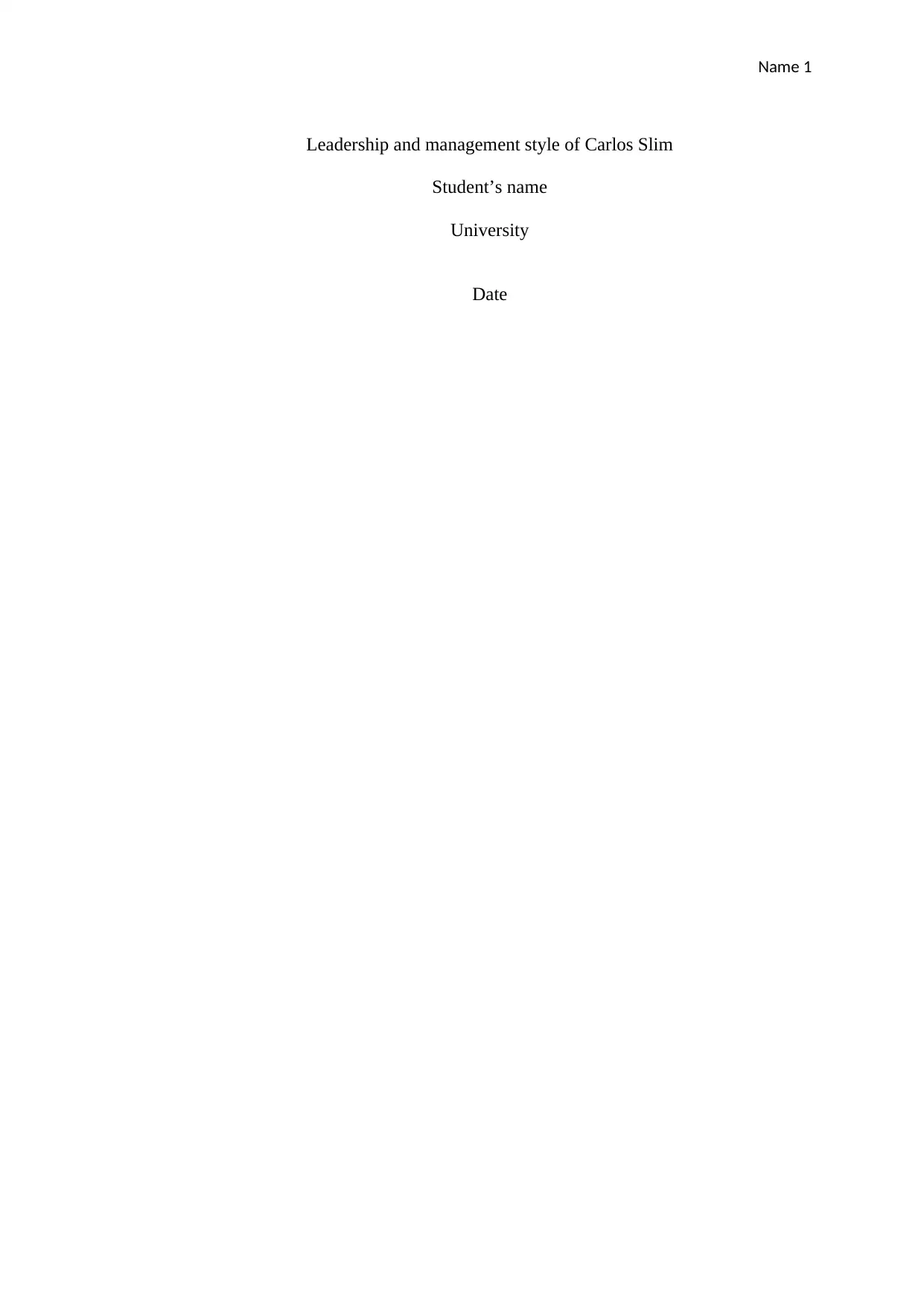
Name 1
Leadership and management style of Carlos Slim
Student’s name
University
Date
Leadership and management style of Carlos Slim
Student’s name
University
Date
Paraphrase This Document
Need a fresh take? Get an instant paraphrase of this document with our AI Paraphraser
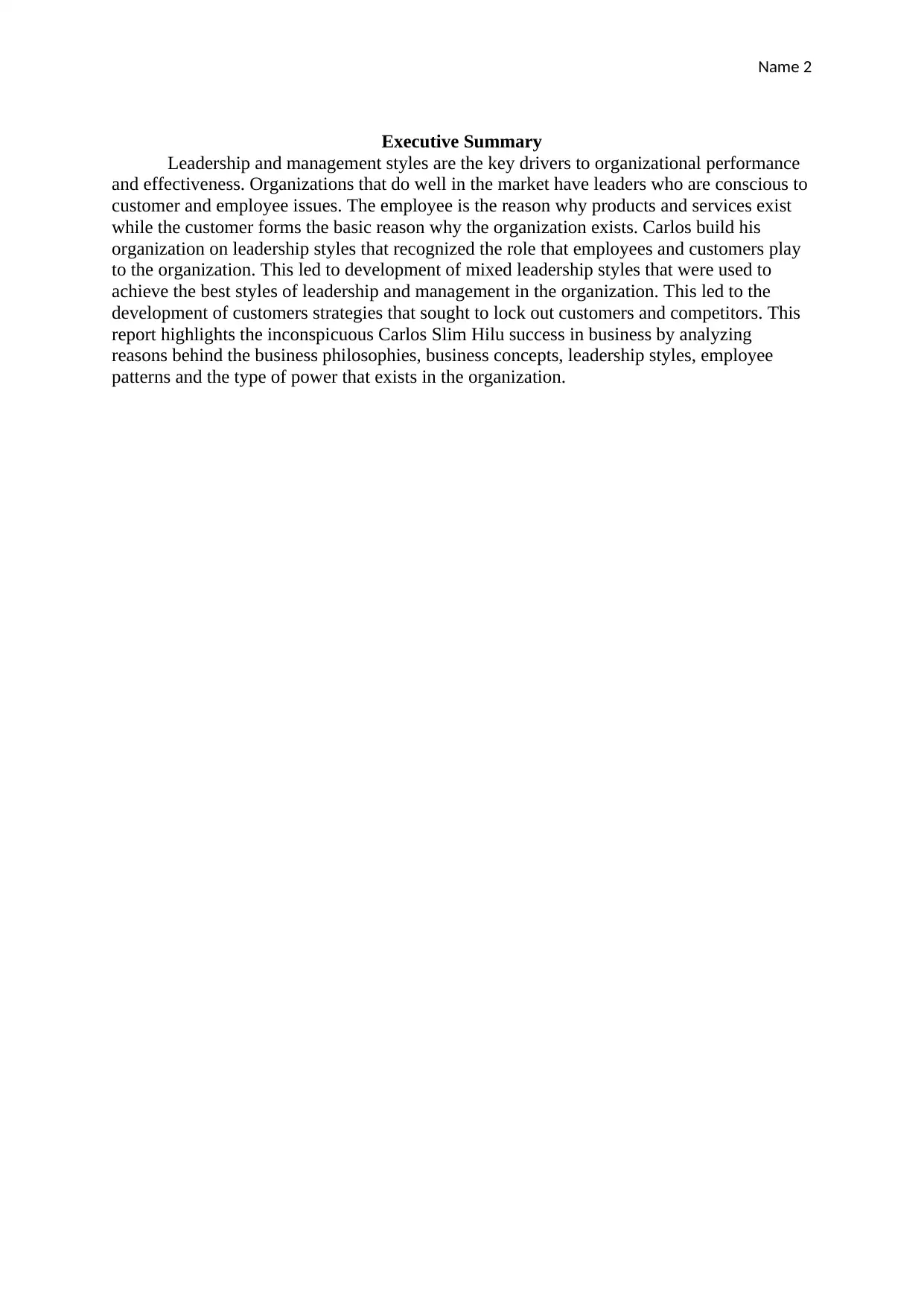
Name 2
Executive Summary
Leadership and management styles are the key drivers to organizational performance
and effectiveness. Organizations that do well in the market have leaders who are conscious to
customer and employee issues. The employee is the reason why products and services exist
while the customer forms the basic reason why the organization exists. Carlos build his
organization on leadership styles that recognized the role that employees and customers play
to the organization. This led to development of mixed leadership styles that were used to
achieve the best styles of leadership and management in the organization. This led to the
development of customers strategies that sought to lock out customers and competitors. This
report highlights the inconspicuous Carlos Slim Hilu success in business by analyzing
reasons behind the business philosophies, business concepts, leadership styles, employee
patterns and the type of power that exists in the organization.
Executive Summary
Leadership and management styles are the key drivers to organizational performance
and effectiveness. Organizations that do well in the market have leaders who are conscious to
customer and employee issues. The employee is the reason why products and services exist
while the customer forms the basic reason why the organization exists. Carlos build his
organization on leadership styles that recognized the role that employees and customers play
to the organization. This led to development of mixed leadership styles that were used to
achieve the best styles of leadership and management in the organization. This led to the
development of customers strategies that sought to lock out customers and competitors. This
report highlights the inconspicuous Carlos Slim Hilu success in business by analyzing
reasons behind the business philosophies, business concepts, leadership styles, employee
patterns and the type of power that exists in the organization.
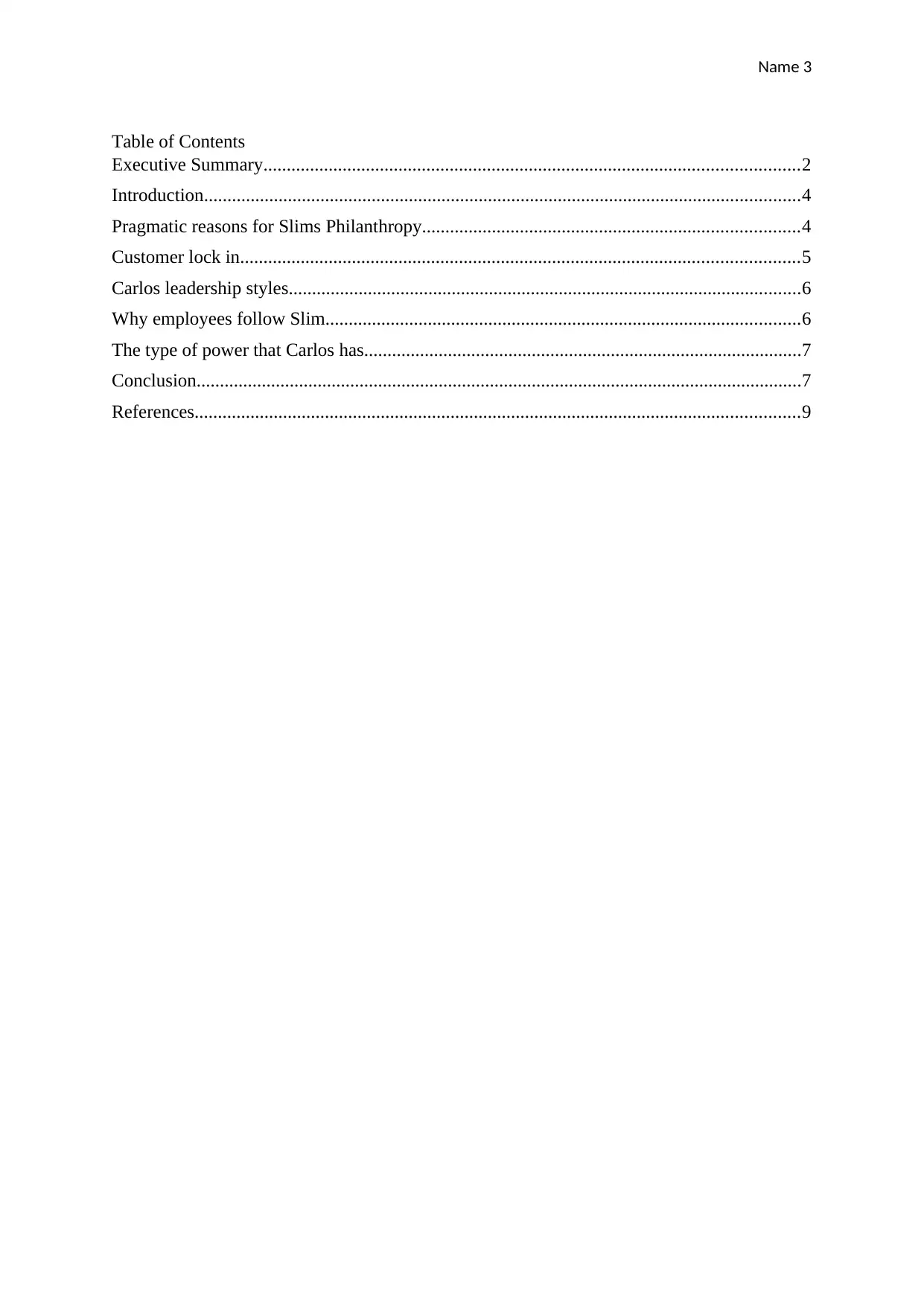
Name 3
Table of Contents
Executive Summary...................................................................................................................2
Introduction................................................................................................................................4
Pragmatic reasons for Slims Philanthropy.................................................................................4
Customer lock in........................................................................................................................5
Carlos leadership styles..............................................................................................................6
Why employees follow Slim......................................................................................................6
The type of power that Carlos has..............................................................................................7
Conclusion..................................................................................................................................7
References..................................................................................................................................9
Table of Contents
Executive Summary...................................................................................................................2
Introduction................................................................................................................................4
Pragmatic reasons for Slims Philanthropy.................................................................................4
Customer lock in........................................................................................................................5
Carlos leadership styles..............................................................................................................6
Why employees follow Slim......................................................................................................6
The type of power that Carlos has..............................................................................................7
Conclusion..................................................................................................................................7
References..................................................................................................................................9
⊘ This is a preview!⊘
Do you want full access?
Subscribe today to unlock all pages.

Trusted by 1+ million students worldwide
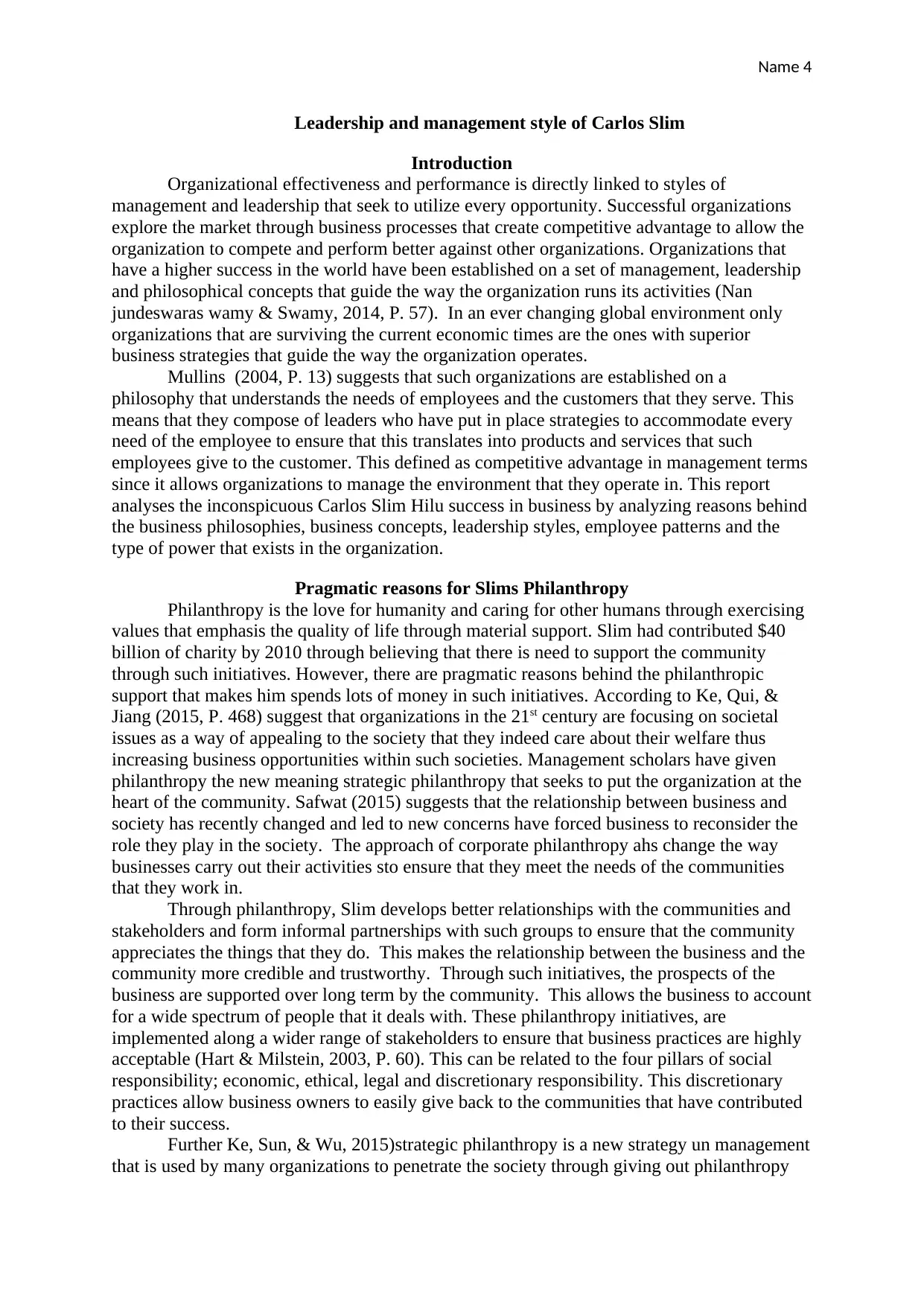
Name 4
Leadership and management style of Carlos Slim
Introduction
Organizational effectiveness and performance is directly linked to styles of
management and leadership that seek to utilize every opportunity. Successful organizations
explore the market through business processes that create competitive advantage to allow the
organization to compete and perform better against other organizations. Organizations that
have a higher success in the world have been established on a set of management, leadership
and philosophical concepts that guide the way the organization runs its activities (Nan
jundeswaras wamy & Swamy, 2014, P. 57). In an ever changing global environment only
organizations that are surviving the current economic times are the ones with superior
business strategies that guide the way the organization operates.
Mullins (2004, P. 13) suggests that such organizations are established on a
philosophy that understands the needs of employees and the customers that they serve. This
means that they compose of leaders who have put in place strategies to accommodate every
need of the employee to ensure that this translates into products and services that such
employees give to the customer. This defined as competitive advantage in management terms
since it allows organizations to manage the environment that they operate in. This report
analyses the inconspicuous Carlos Slim Hilu success in business by analyzing reasons behind
the business philosophies, business concepts, leadership styles, employee patterns and the
type of power that exists in the organization.
Pragmatic reasons for Slims Philanthropy
Philanthropy is the love for humanity and caring for other humans through exercising
values that emphasis the quality of life through material support. Slim had contributed $40
billion of charity by 2010 through believing that there is need to support the community
through such initiatives. However, there are pragmatic reasons behind the philanthropic
support that makes him spends lots of money in such initiatives. According to Ke, Qui, &
Jiang (2015, P. 468) suggest that organizations in the 21st century are focusing on societal
issues as a way of appealing to the society that they indeed care about their welfare thus
increasing business opportunities within such societies. Management scholars have given
philanthropy the new meaning strategic philanthropy that seeks to put the organization at the
heart of the community. Safwat (2015) suggests that the relationship between business and
society has recently changed and led to new concerns have forced business to reconsider the
role they play in the society. The approach of corporate philanthropy ahs change the way
businesses carry out their activities sto ensure that they meet the needs of the communities
that they work in.
Through philanthropy, Slim develops better relationships with the communities and
stakeholders and form informal partnerships with such groups to ensure that the community
appreciates the things that they do. This makes the relationship between the business and the
community more credible and trustworthy. Through such initiatives, the prospects of the
business are supported over long term by the community. This allows the business to account
for a wide spectrum of people that it deals with. These philanthropy initiatives, are
implemented along a wider range of stakeholders to ensure that business practices are highly
acceptable (Hart & Milstein, 2003, P. 60). This can be related to the four pillars of social
responsibility; economic, ethical, legal and discretionary responsibility. This discretionary
practices allow business owners to easily give back to the communities that have contributed
to their success.
Further Ke, Sun, & Wu, 2015)strategic philanthropy is a new strategy un management
that is used by many organizations to penetrate the society through giving out philanthropy
Leadership and management style of Carlos Slim
Introduction
Organizational effectiveness and performance is directly linked to styles of
management and leadership that seek to utilize every opportunity. Successful organizations
explore the market through business processes that create competitive advantage to allow the
organization to compete and perform better against other organizations. Organizations that
have a higher success in the world have been established on a set of management, leadership
and philosophical concepts that guide the way the organization runs its activities (Nan
jundeswaras wamy & Swamy, 2014, P. 57). In an ever changing global environment only
organizations that are surviving the current economic times are the ones with superior
business strategies that guide the way the organization operates.
Mullins (2004, P. 13) suggests that such organizations are established on a
philosophy that understands the needs of employees and the customers that they serve. This
means that they compose of leaders who have put in place strategies to accommodate every
need of the employee to ensure that this translates into products and services that such
employees give to the customer. This defined as competitive advantage in management terms
since it allows organizations to manage the environment that they operate in. This report
analyses the inconspicuous Carlos Slim Hilu success in business by analyzing reasons behind
the business philosophies, business concepts, leadership styles, employee patterns and the
type of power that exists in the organization.
Pragmatic reasons for Slims Philanthropy
Philanthropy is the love for humanity and caring for other humans through exercising
values that emphasis the quality of life through material support. Slim had contributed $40
billion of charity by 2010 through believing that there is need to support the community
through such initiatives. However, there are pragmatic reasons behind the philanthropic
support that makes him spends lots of money in such initiatives. According to Ke, Qui, &
Jiang (2015, P. 468) suggest that organizations in the 21st century are focusing on societal
issues as a way of appealing to the society that they indeed care about their welfare thus
increasing business opportunities within such societies. Management scholars have given
philanthropy the new meaning strategic philanthropy that seeks to put the organization at the
heart of the community. Safwat (2015) suggests that the relationship between business and
society has recently changed and led to new concerns have forced business to reconsider the
role they play in the society. The approach of corporate philanthropy ahs change the way
businesses carry out their activities sto ensure that they meet the needs of the communities
that they work in.
Through philanthropy, Slim develops better relationships with the communities and
stakeholders and form informal partnerships with such groups to ensure that the community
appreciates the things that they do. This makes the relationship between the business and the
community more credible and trustworthy. Through such initiatives, the prospects of the
business are supported over long term by the community. This allows the business to account
for a wide spectrum of people that it deals with. These philanthropy initiatives, are
implemented along a wider range of stakeholders to ensure that business practices are highly
acceptable (Hart & Milstein, 2003, P. 60). This can be related to the four pillars of social
responsibility; economic, ethical, legal and discretionary responsibility. This discretionary
practices allow business owners to easily give back to the communities that have contributed
to their success.
Further Ke, Sun, & Wu, 2015)strategic philanthropy is a new strategy un management
that is used by many organizations to penetrate the society through giving out philanthropy
Paraphrase This Document
Need a fresh take? Get an instant paraphrase of this document with our AI Paraphraser
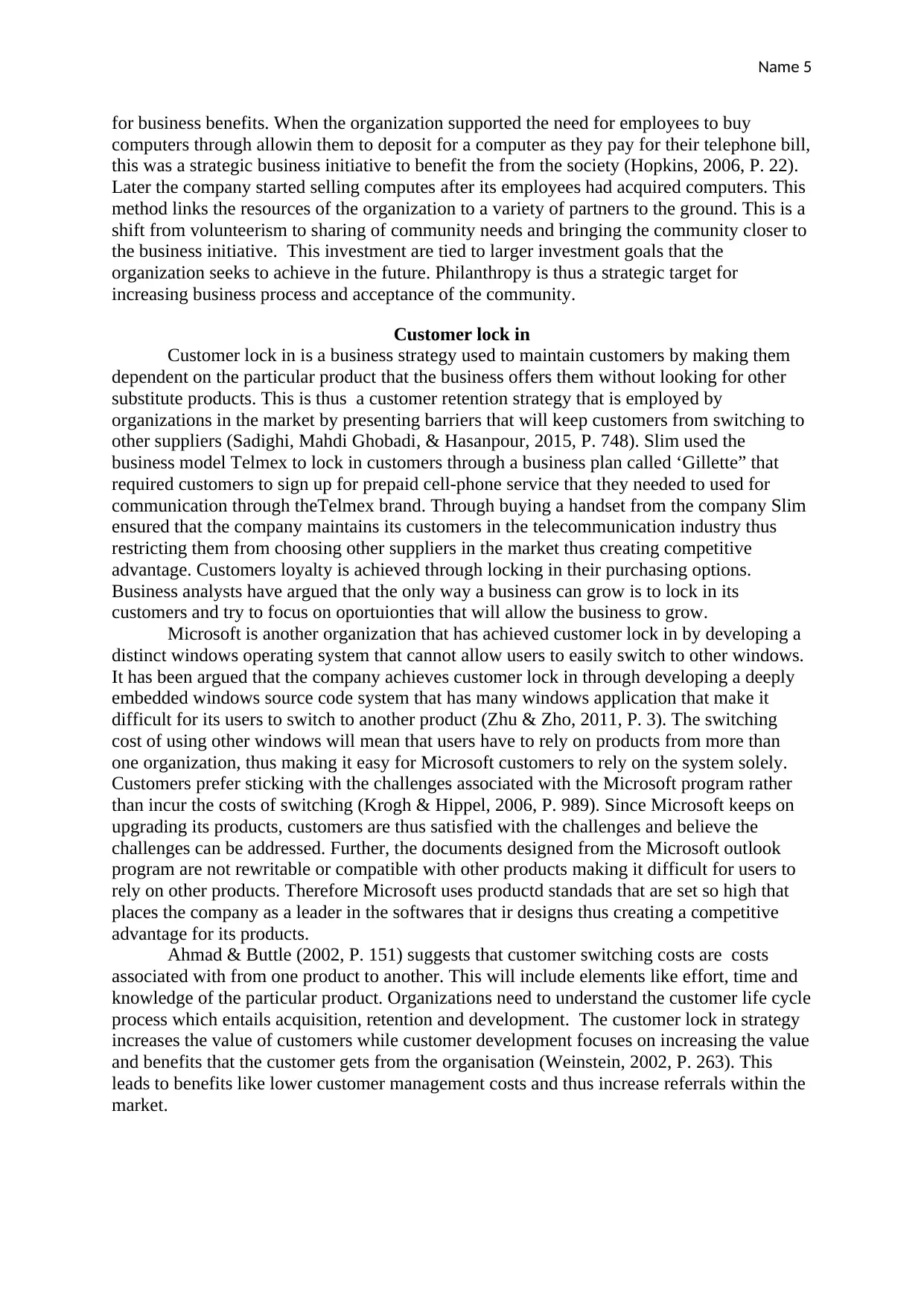
Name 5
for business benefits. When the organization supported the need for employees to buy
computers through allowin them to deposit for a computer as they pay for their telephone bill,
this was a strategic business initiative to benefit the from the society (Hopkins, 2006, P. 22).
Later the company started selling computes after its employees had acquired computers. This
method links the resources of the organization to a variety of partners to the ground. This is a
shift from volunteerism to sharing of community needs and bringing the community closer to
the business initiative. This investment are tied to larger investment goals that the
organization seeks to achieve in the future. Philanthropy is thus a strategic target for
increasing business process and acceptance of the community.
Customer lock in
Customer lock in is a business strategy used to maintain customers by making them
dependent on the particular product that the business offers them without looking for other
substitute products. This is thus a customer retention strategy that is employed by
organizations in the market by presenting barriers that will keep customers from switching to
other suppliers (Sadighi, Mahdi Ghobadi, & Hasanpour, 2015, P. 748). Slim used the
business model Telmex to lock in customers through a business plan called ‘Gillette” that
required customers to sign up for prepaid cell-phone service that they needed to used for
communication through theTelmex brand. Through buying a handset from the company Slim
ensured that the company maintains its customers in the telecommunication industry thus
restricting them from choosing other suppliers in the market thus creating competitive
advantage. Customers loyalty is achieved through locking in their purchasing options.
Business analysts have argued that the only way a business can grow is to lock in its
customers and try to focus on oportuionties that will allow the business to grow.
Microsoft is another organization that has achieved customer lock in by developing a
distinct windows operating system that cannot allow users to easily switch to other windows.
It has been argued that the company achieves customer lock in through developing a deeply
embedded windows source code system that has many windows application that make it
difficult for its users to switch to another product (Zhu & Zho, 2011, P. 3). The switching
cost of using other windows will mean that users have to rely on products from more than
one organization, thus making it easy for Microsoft customers to rely on the system solely.
Customers prefer sticking with the challenges associated with the Microsoft program rather
than incur the costs of switching (Krogh & Hippel, 2006, P. 989). Since Microsoft keeps on
upgrading its products, customers are thus satisfied with the challenges and believe the
challenges can be addressed. Further, the documents designed from the Microsoft outlook
program are not rewritable or compatible with other products making it difficult for users to
rely on other products. Therefore Microsoft uses productd standads that are set so high that
places the company as a leader in the softwares that ir designs thus creating a competitive
advantage for its products.
Ahmad & Buttle (2002, P. 151) suggests that customer switching costs are costs
associated with from one product to another. This will include elements like effort, time and
knowledge of the particular product. Organizations need to understand the customer life cycle
process which entails acquisition, retention and development. The customer lock in strategy
increases the value of customers while customer development focuses on increasing the value
and benefits that the customer gets from the organisation (Weinstein, 2002, P. 263). This
leads to benefits like lower customer management costs and thus increase referrals within the
market.
for business benefits. When the organization supported the need for employees to buy
computers through allowin them to deposit for a computer as they pay for their telephone bill,
this was a strategic business initiative to benefit the from the society (Hopkins, 2006, P. 22).
Later the company started selling computes after its employees had acquired computers. This
method links the resources of the organization to a variety of partners to the ground. This is a
shift from volunteerism to sharing of community needs and bringing the community closer to
the business initiative. This investment are tied to larger investment goals that the
organization seeks to achieve in the future. Philanthropy is thus a strategic target for
increasing business process and acceptance of the community.
Customer lock in
Customer lock in is a business strategy used to maintain customers by making them
dependent on the particular product that the business offers them without looking for other
substitute products. This is thus a customer retention strategy that is employed by
organizations in the market by presenting barriers that will keep customers from switching to
other suppliers (Sadighi, Mahdi Ghobadi, & Hasanpour, 2015, P. 748). Slim used the
business model Telmex to lock in customers through a business plan called ‘Gillette” that
required customers to sign up for prepaid cell-phone service that they needed to used for
communication through theTelmex brand. Through buying a handset from the company Slim
ensured that the company maintains its customers in the telecommunication industry thus
restricting them from choosing other suppliers in the market thus creating competitive
advantage. Customers loyalty is achieved through locking in their purchasing options.
Business analysts have argued that the only way a business can grow is to lock in its
customers and try to focus on oportuionties that will allow the business to grow.
Microsoft is another organization that has achieved customer lock in by developing a
distinct windows operating system that cannot allow users to easily switch to other windows.
It has been argued that the company achieves customer lock in through developing a deeply
embedded windows source code system that has many windows application that make it
difficult for its users to switch to another product (Zhu & Zho, 2011, P. 3). The switching
cost of using other windows will mean that users have to rely on products from more than
one organization, thus making it easy for Microsoft customers to rely on the system solely.
Customers prefer sticking with the challenges associated with the Microsoft program rather
than incur the costs of switching (Krogh & Hippel, 2006, P. 989). Since Microsoft keeps on
upgrading its products, customers are thus satisfied with the challenges and believe the
challenges can be addressed. Further, the documents designed from the Microsoft outlook
program are not rewritable or compatible with other products making it difficult for users to
rely on other products. Therefore Microsoft uses productd standads that are set so high that
places the company as a leader in the softwares that ir designs thus creating a competitive
advantage for its products.
Ahmad & Buttle (2002, P. 151) suggests that customer switching costs are costs
associated with from one product to another. This will include elements like effort, time and
knowledge of the particular product. Organizations need to understand the customer life cycle
process which entails acquisition, retention and development. The customer lock in strategy
increases the value of customers while customer development focuses on increasing the value
and benefits that the customer gets from the organisation (Weinstein, 2002, P. 263). This
leads to benefits like lower customer management costs and thus increase referrals within the
market.
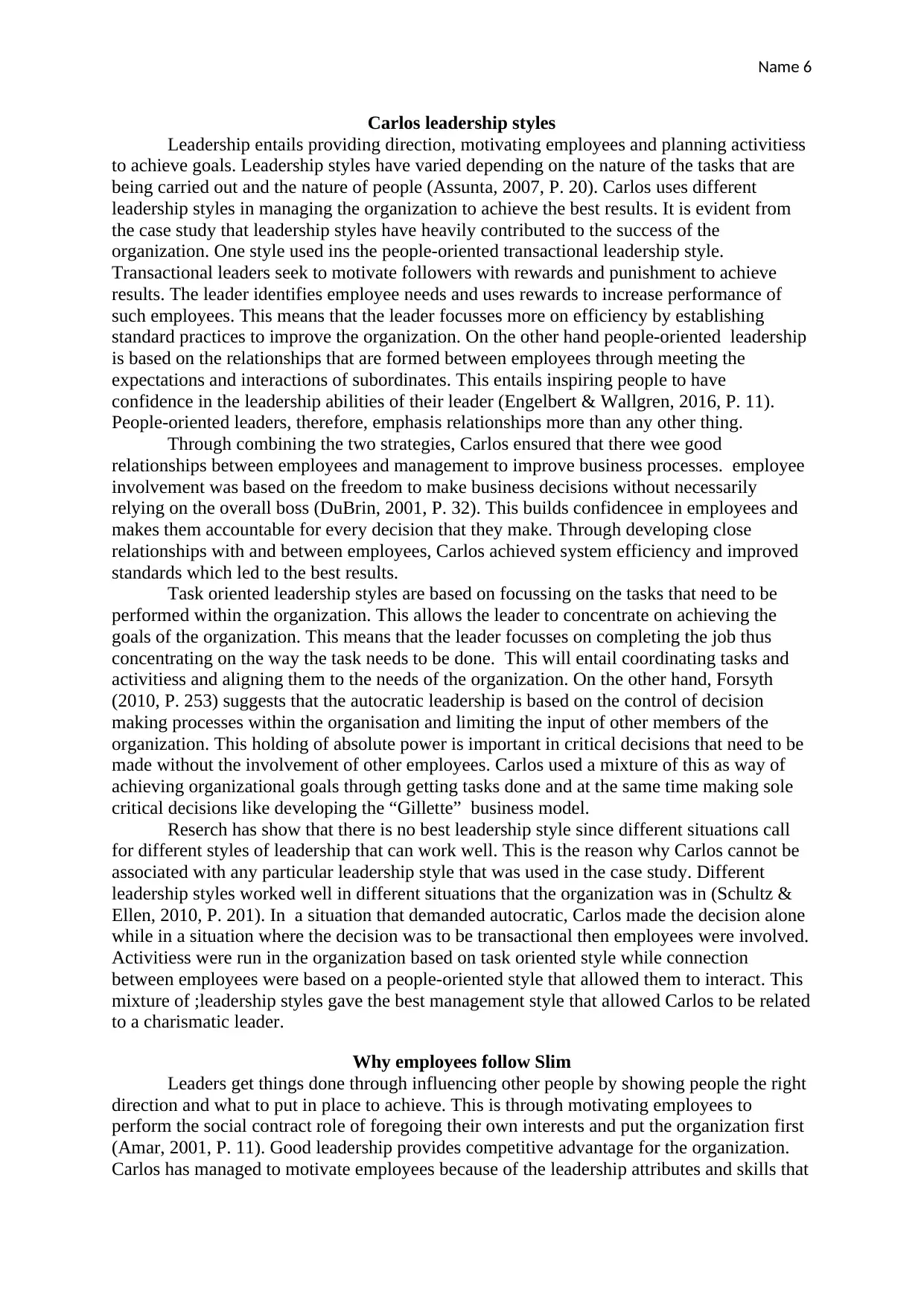
Name 6
Carlos leadership styles
Leadership entails providing direction, motivating employees and planning activitiess
to achieve goals. Leadership styles have varied depending on the nature of the tasks that are
being carried out and the nature of people (Assunta, 2007, P. 20). Carlos uses different
leadership styles in managing the organization to achieve the best results. It is evident from
the case study that leadership styles have heavily contributed to the success of the
organization. One style used ins the people-oriented transactional leadership style.
Transactional leaders seek to motivate followers with rewards and punishment to achieve
results. The leader identifies employee needs and uses rewards to increase performance of
such employees. This means that the leader focusses more on efficiency by establishing
standard practices to improve the organization. On the other hand people-oriented leadership
is based on the relationships that are formed between employees through meeting the
expectations and interactions of subordinates. This entails inspiring people to have
confidence in the leadership abilities of their leader (Engelbert & Wallgren, 2016, P. 11).
People-oriented leaders, therefore, emphasis relationships more than any other thing.
Through combining the two strategies, Carlos ensured that there wee good
relationships between employees and management to improve business processes. employee
involvement was based on the freedom to make business decisions without necessarily
relying on the overall boss (DuBrin, 2001, P. 32). This builds confidencee in employees and
makes them accountable for every decision that they make. Through developing close
relationships with and between employees, Carlos achieved system efficiency and improved
standards which led to the best results.
Task oriented leadership styles are based on focussing on the tasks that need to be
performed within the organization. This allows the leader to concentrate on achieving the
goals of the organization. This means that the leader focusses on completing the job thus
concentrating on the way the task needs to be done. This will entail coordinating tasks and
activitiess and aligning them to the needs of the organization. On the other hand, Forsyth
(2010, P. 253) suggests that the autocratic leadership is based on the control of decision
making processes within the organisation and limiting the input of other members of the
organization. This holding of absolute power is important in critical decisions that need to be
made without the involvement of other employees. Carlos used a mixture of this as way of
achieving organizational goals through getting tasks done and at the same time making sole
critical decisions like developing the “Gillette” business model.
Reserch has show that there is no best leadership style since different situations call
for different styles of leadership that can work well. This is the reason why Carlos cannot be
associated with any particular leadership style that was used in the case study. Different
leadership styles worked well in different situations that the organization was in (Schultz &
Ellen, 2010, P. 201). In a situation that demanded autocratic, Carlos made the decision alone
while in a situation where the decision was to be transactional then employees were involved.
Activitiess were run in the organization based on task oriented style while connection
between employees were based on a people-oriented style that allowed them to interact. This
mixture of ;leadership styles gave the best management style that allowed Carlos to be related
to a charismatic leader.
Why employees follow Slim
Leaders get things done through influencing other people by showing people the right
direction and what to put in place to achieve. This is through motivating employees to
perform the social contract role of foregoing their own interests and put the organization first
(Amar, 2001, P. 11). Good leadership provides competitive advantage for the organization.
Carlos has managed to motivate employees because of the leadership attributes and skills that
Carlos leadership styles
Leadership entails providing direction, motivating employees and planning activitiess
to achieve goals. Leadership styles have varied depending on the nature of the tasks that are
being carried out and the nature of people (Assunta, 2007, P. 20). Carlos uses different
leadership styles in managing the organization to achieve the best results. It is evident from
the case study that leadership styles have heavily contributed to the success of the
organization. One style used ins the people-oriented transactional leadership style.
Transactional leaders seek to motivate followers with rewards and punishment to achieve
results. The leader identifies employee needs and uses rewards to increase performance of
such employees. This means that the leader focusses more on efficiency by establishing
standard practices to improve the organization. On the other hand people-oriented leadership
is based on the relationships that are formed between employees through meeting the
expectations and interactions of subordinates. This entails inspiring people to have
confidence in the leadership abilities of their leader (Engelbert & Wallgren, 2016, P. 11).
People-oriented leaders, therefore, emphasis relationships more than any other thing.
Through combining the two strategies, Carlos ensured that there wee good
relationships between employees and management to improve business processes. employee
involvement was based on the freedom to make business decisions without necessarily
relying on the overall boss (DuBrin, 2001, P. 32). This builds confidencee in employees and
makes them accountable for every decision that they make. Through developing close
relationships with and between employees, Carlos achieved system efficiency and improved
standards which led to the best results.
Task oriented leadership styles are based on focussing on the tasks that need to be
performed within the organization. This allows the leader to concentrate on achieving the
goals of the organization. This means that the leader focusses on completing the job thus
concentrating on the way the task needs to be done. This will entail coordinating tasks and
activitiess and aligning them to the needs of the organization. On the other hand, Forsyth
(2010, P. 253) suggests that the autocratic leadership is based on the control of decision
making processes within the organisation and limiting the input of other members of the
organization. This holding of absolute power is important in critical decisions that need to be
made without the involvement of other employees. Carlos used a mixture of this as way of
achieving organizational goals through getting tasks done and at the same time making sole
critical decisions like developing the “Gillette” business model.
Reserch has show that there is no best leadership style since different situations call
for different styles of leadership that can work well. This is the reason why Carlos cannot be
associated with any particular leadership style that was used in the case study. Different
leadership styles worked well in different situations that the organization was in (Schultz &
Ellen, 2010, P. 201). In a situation that demanded autocratic, Carlos made the decision alone
while in a situation where the decision was to be transactional then employees were involved.
Activitiess were run in the organization based on task oriented style while connection
between employees were based on a people-oriented style that allowed them to interact. This
mixture of ;leadership styles gave the best management style that allowed Carlos to be related
to a charismatic leader.
Why employees follow Slim
Leaders get things done through influencing other people by showing people the right
direction and what to put in place to achieve. This is through motivating employees to
perform the social contract role of foregoing their own interests and put the organization first
(Amar, 2001, P. 11). Good leadership provides competitive advantage for the organization.
Carlos has managed to motivate employees because of the leadership attributes and skills that
⊘ This is a preview!⊘
Do you want full access?
Subscribe today to unlock all pages.

Trusted by 1+ million students worldwide
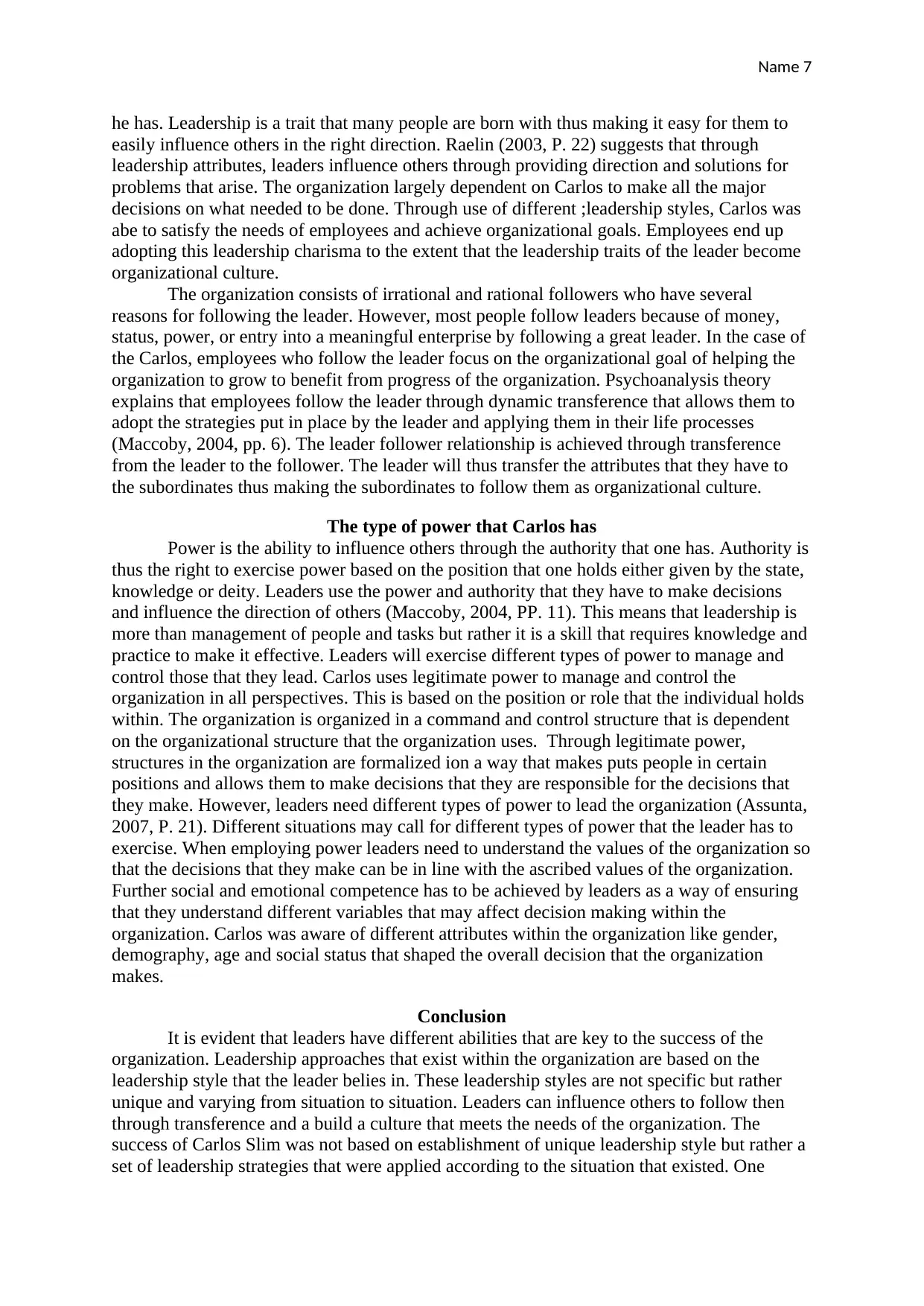
Name 7
he has. Leadership is a trait that many people are born with thus making it easy for them to
easily influence others in the right direction. Raelin (2003, P. 22) suggests that through
leadership attributes, leaders influence others through providing direction and solutions for
problems that arise. The organization largely dependent on Carlos to make all the major
decisions on what needed to be done. Through use of different ;leadership styles, Carlos was
abe to satisfy the needs of employees and achieve organizational goals. Employees end up
adopting this leadership charisma to the extent that the leadership traits of the leader become
organizational culture.
The organization consists of irrational and rational followers who have several
reasons for following the leader. However, most people follow leaders because of money,
status, power, or entry into a meaningful enterprise by following a great leader. In the case of
the Carlos, employees who follow the leader focus on the organizational goal of helping the
organization to grow to benefit from progress of the organization. Psychoanalysis theory
explains that employees follow the leader through dynamic transference that allows them to
adopt the strategies put in place by the leader and applying them in their life processes
(Maccoby, 2004, pp. 6). The leader follower relationship is achieved through transference
from the leader to the follower. The leader will thus transfer the attributes that they have to
the subordinates thus making the subordinates to follow them as organizational culture.
The type of power that Carlos has
Power is the ability to influence others through the authority that one has. Authority is
thus the right to exercise power based on the position that one holds either given by the state,
knowledge or deity. Leaders use the power and authority that they have to make decisions
and influence the direction of others (Maccoby, 2004, PP. 11). This means that leadership is
more than management of people and tasks but rather it is a skill that requires knowledge and
practice to make it effective. Leaders will exercise different types of power to manage and
control those that they lead. Carlos uses legitimate power to manage and control the
organization in all perspectives. This is based on the position or role that the individual holds
within. The organization is organized in a command and control structure that is dependent
on the organizational structure that the organization uses. Through legitimate power,
structures in the organization are formalized ion a way that makes puts people in certain
positions and allows them to make decisions that they are responsible for the decisions that
they make. However, leaders need different types of power to lead the organization (Assunta,
2007, P. 21). Different situations may call for different types of power that the leader has to
exercise. When employing power leaders need to understand the values of the organization so
that the decisions that they make can be in line with the ascribed values of the organization.
Further social and emotional competence has to be achieved by leaders as a way of ensuring
that they understand different variables that may affect decision making within the
organization. Carlos was aware of different attributes within the organization like gender,
demography, age and social status that shaped the overall decision that the organization
makes.
Conclusion
It is evident that leaders have different abilities that are key to the success of the
organization. Leadership approaches that exist within the organization are based on the
leadership style that the leader belies in. These leadership styles are not specific but rather
unique and varying from situation to situation. Leaders can influence others to follow then
through transference and a build a culture that meets the needs of the organization. The
success of Carlos Slim was not based on establishment of unique leadership style but rather a
set of leadership strategies that were applied according to the situation that existed. One
he has. Leadership is a trait that many people are born with thus making it easy for them to
easily influence others in the right direction. Raelin (2003, P. 22) suggests that through
leadership attributes, leaders influence others through providing direction and solutions for
problems that arise. The organization largely dependent on Carlos to make all the major
decisions on what needed to be done. Through use of different ;leadership styles, Carlos was
abe to satisfy the needs of employees and achieve organizational goals. Employees end up
adopting this leadership charisma to the extent that the leadership traits of the leader become
organizational culture.
The organization consists of irrational and rational followers who have several
reasons for following the leader. However, most people follow leaders because of money,
status, power, or entry into a meaningful enterprise by following a great leader. In the case of
the Carlos, employees who follow the leader focus on the organizational goal of helping the
organization to grow to benefit from progress of the organization. Psychoanalysis theory
explains that employees follow the leader through dynamic transference that allows them to
adopt the strategies put in place by the leader and applying them in their life processes
(Maccoby, 2004, pp. 6). The leader follower relationship is achieved through transference
from the leader to the follower. The leader will thus transfer the attributes that they have to
the subordinates thus making the subordinates to follow them as organizational culture.
The type of power that Carlos has
Power is the ability to influence others through the authority that one has. Authority is
thus the right to exercise power based on the position that one holds either given by the state,
knowledge or deity. Leaders use the power and authority that they have to make decisions
and influence the direction of others (Maccoby, 2004, PP. 11). This means that leadership is
more than management of people and tasks but rather it is a skill that requires knowledge and
practice to make it effective. Leaders will exercise different types of power to manage and
control those that they lead. Carlos uses legitimate power to manage and control the
organization in all perspectives. This is based on the position or role that the individual holds
within. The organization is organized in a command and control structure that is dependent
on the organizational structure that the organization uses. Through legitimate power,
structures in the organization are formalized ion a way that makes puts people in certain
positions and allows them to make decisions that they are responsible for the decisions that
they make. However, leaders need different types of power to lead the organization (Assunta,
2007, P. 21). Different situations may call for different types of power that the leader has to
exercise. When employing power leaders need to understand the values of the organization so
that the decisions that they make can be in line with the ascribed values of the organization.
Further social and emotional competence has to be achieved by leaders as a way of ensuring
that they understand different variables that may affect decision making within the
organization. Carlos was aware of different attributes within the organization like gender,
demography, age and social status that shaped the overall decision that the organization
makes.
Conclusion
It is evident that leaders have different abilities that are key to the success of the
organization. Leadership approaches that exist within the organization are based on the
leadership style that the leader belies in. These leadership styles are not specific but rather
unique and varying from situation to situation. Leaders can influence others to follow then
through transference and a build a culture that meets the needs of the organization. The
success of Carlos Slim was not based on establishment of unique leadership style but rather a
set of leadership strategies that were applied according to the situation that existed. One
Paraphrase This Document
Need a fresh take? Get an instant paraphrase of this document with our AI Paraphraser
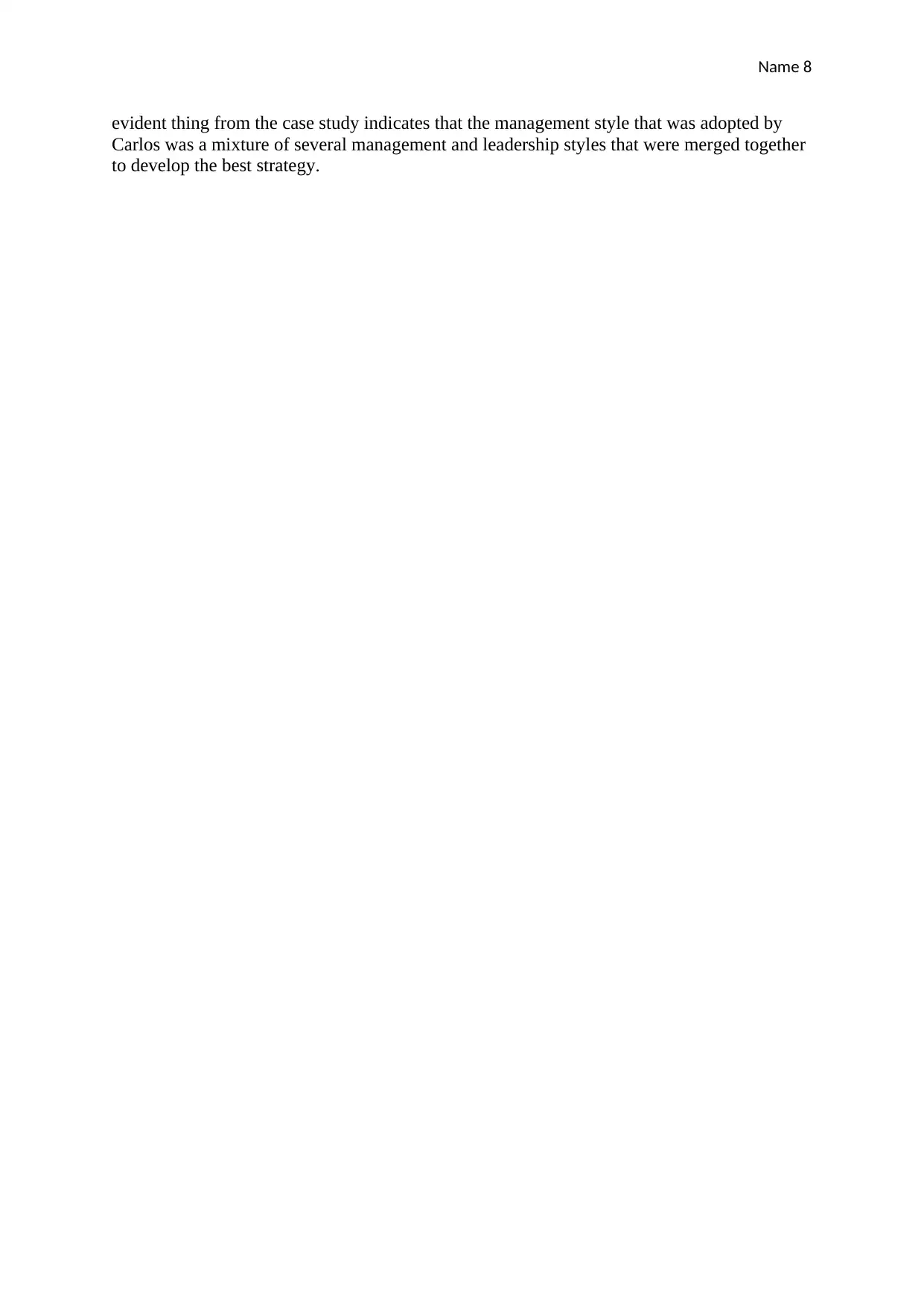
Name 8
evident thing from the case study indicates that the management style that was adopted by
Carlos was a mixture of several management and leadership styles that were merged together
to develop the best strategy.
evident thing from the case study indicates that the management style that was adopted by
Carlos was a mixture of several management and leadership styles that were merged together
to develop the best strategy.
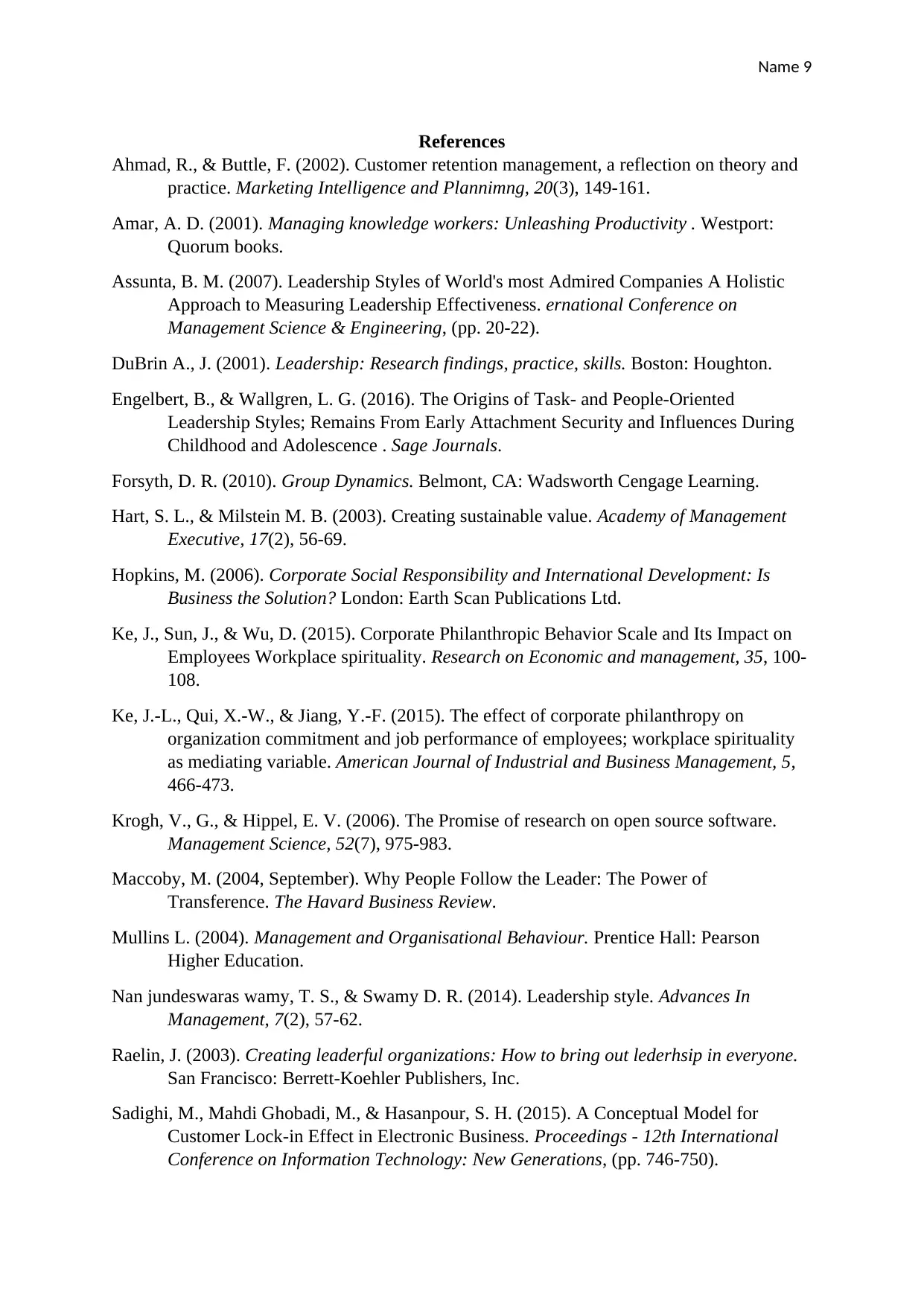
Name 9
References
Ahmad, R., & Buttle, F. (2002). Customer retention management, a reflection on theory and
practice. Marketing Intelligence and Plannimng, 20(3), 149-161.
Amar, A. D. (2001). Managing knowledge workers: Unleashing Productivity . Westport:
Quorum books.
Assunta, B. M. (2007). Leadership Styles of World's most Admired Companies A Holistic
Approach to Measuring Leadership Effectiveness. ernational Conference on
Management Science & Engineering, (pp. 20-22).
DuBrin A., J. (2001). Leadership: Research findings, practice, skills. Boston: Houghton.
Engelbert, B., & Wallgren, L. G. (2016). The Origins of Task- and People-Oriented
Leadership Styles; Remains From Early Attachment Security and Influences During
Childhood and Adolescence . Sage Journals.
Forsyth, D. R. (2010). Group Dynamics. Belmont, CA: Wadsworth Cengage Learning.
Hart, S. L., & Milstein M. B. (2003). Creating sustainable value. Academy of Management
Executive, 17(2), 56-69.
Hopkins, M. (2006). Corporate Social Responsibility and International Development: Is
Business the Solution? London: Earth Scan Publications Ltd.
Ke, J., Sun, J., & Wu, D. (2015). Corporate Philanthropic Behavior Scale and Its Impact on
Employees Workplace spirituality. Research on Economic and management, 35, 100-
108.
Ke, J.-L., Qui, X.-W., & Jiang, Y.-F. (2015). The effect of corporate philanthropy on
organization commitment and job performance of employees; workplace spirituality
as mediating variable. American Journal of Industrial and Business Management, 5,
466-473.
Krogh, V., G., & Hippel, E. V. (2006). The Promise of research on open source software.
Management Science, 52(7), 975-983.
Maccoby, M. (2004, September). Why People Follow the Leader: The Power of
Transference. The Havard Business Review.
Mullins L. (2004). Management and Organisational Behaviour. Prentice Hall: Pearson
Higher Education.
Nan jundeswaras wamy, T. S., & Swamy D. R. (2014). Leadership style. Advances In
Management, 7(2), 57-62.
Raelin, J. (2003). Creating leaderful organizations: How to bring out lederhsip in everyone.
San Francisco: Berrett-Koehler Publishers, Inc.
Sadighi, M., Mahdi Ghobadi, M., & Hasanpour, S. H. (2015). A Conceptual Model for
Customer Lock-in Effect in Electronic Business. Proceedings - 12th International
Conference on Information Technology: New Generations, (pp. 746-750).
References
Ahmad, R., & Buttle, F. (2002). Customer retention management, a reflection on theory and
practice. Marketing Intelligence and Plannimng, 20(3), 149-161.
Amar, A. D. (2001). Managing knowledge workers: Unleashing Productivity . Westport:
Quorum books.
Assunta, B. M. (2007). Leadership Styles of World's most Admired Companies A Holistic
Approach to Measuring Leadership Effectiveness. ernational Conference on
Management Science & Engineering, (pp. 20-22).
DuBrin A., J. (2001). Leadership: Research findings, practice, skills. Boston: Houghton.
Engelbert, B., & Wallgren, L. G. (2016). The Origins of Task- and People-Oriented
Leadership Styles; Remains From Early Attachment Security and Influences During
Childhood and Adolescence . Sage Journals.
Forsyth, D. R. (2010). Group Dynamics. Belmont, CA: Wadsworth Cengage Learning.
Hart, S. L., & Milstein M. B. (2003). Creating sustainable value. Academy of Management
Executive, 17(2), 56-69.
Hopkins, M. (2006). Corporate Social Responsibility and International Development: Is
Business the Solution? London: Earth Scan Publications Ltd.
Ke, J., Sun, J., & Wu, D. (2015). Corporate Philanthropic Behavior Scale and Its Impact on
Employees Workplace spirituality. Research on Economic and management, 35, 100-
108.
Ke, J.-L., Qui, X.-W., & Jiang, Y.-F. (2015). The effect of corporate philanthropy on
organization commitment and job performance of employees; workplace spirituality
as mediating variable. American Journal of Industrial and Business Management, 5,
466-473.
Krogh, V., G., & Hippel, E. V. (2006). The Promise of research on open source software.
Management Science, 52(7), 975-983.
Maccoby, M. (2004, September). Why People Follow the Leader: The Power of
Transference. The Havard Business Review.
Mullins L. (2004). Management and Organisational Behaviour. Prentice Hall: Pearson
Higher Education.
Nan jundeswaras wamy, T. S., & Swamy D. R. (2014). Leadership style. Advances In
Management, 7(2), 57-62.
Raelin, J. (2003). Creating leaderful organizations: How to bring out lederhsip in everyone.
San Francisco: Berrett-Koehler Publishers, Inc.
Sadighi, M., Mahdi Ghobadi, M., & Hasanpour, S. H. (2015). A Conceptual Model for
Customer Lock-in Effect in Electronic Business. Proceedings - 12th International
Conference on Information Technology: New Generations, (pp. 746-750).
⊘ This is a preview!⊘
Do you want full access?
Subscribe today to unlock all pages.

Trusted by 1+ million students worldwide
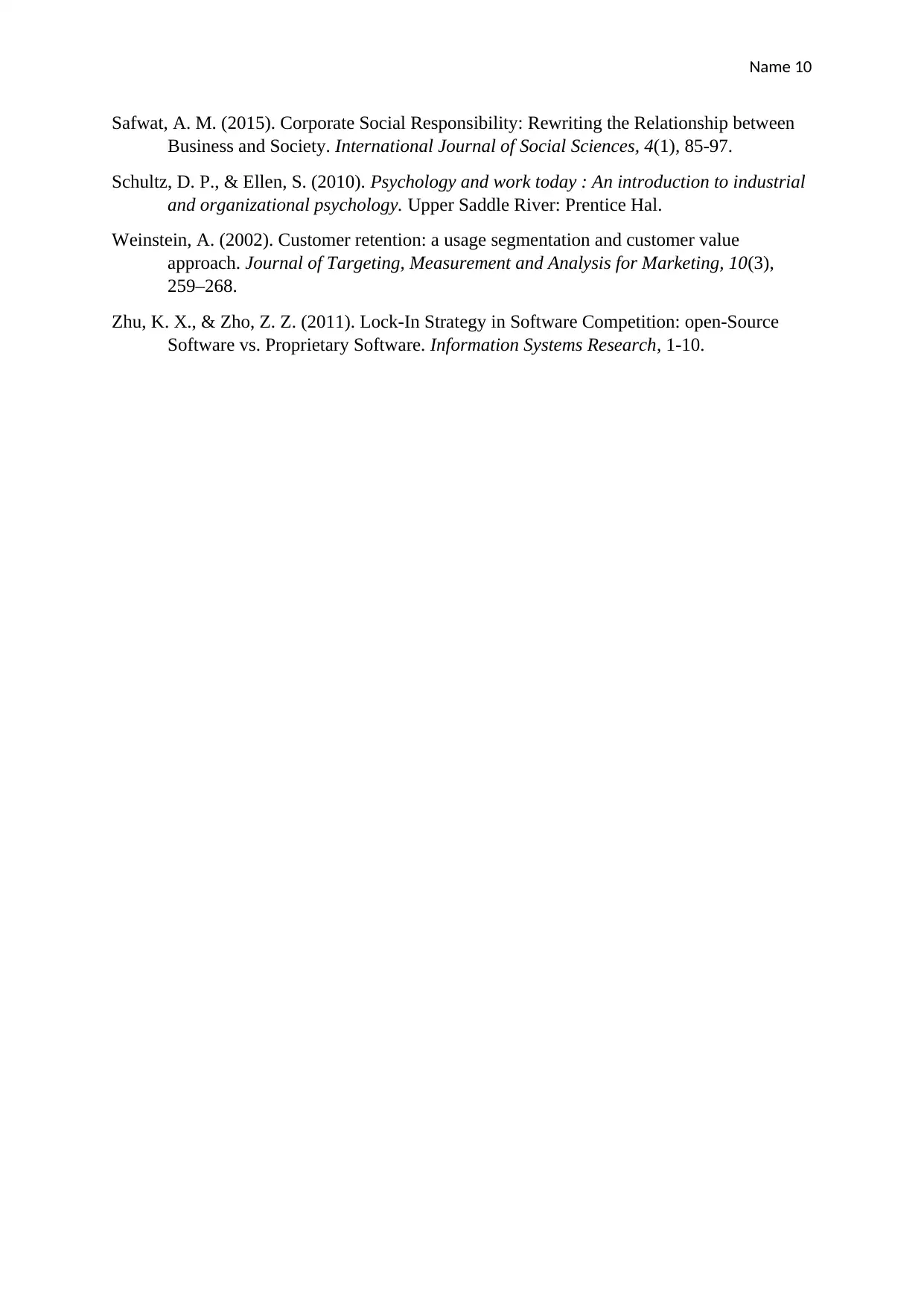
Name 10
Safwat, A. M. (2015). Corporate Social Responsibility: Rewriting the Relationship between
Business and Society. International Journal of Social Sciences, 4(1), 85-97.
Schultz, D. P., & Ellen, S. (2010). Psychology and work today : An introduction to industrial
and organizational psychology. Upper Saddle River: Prentice Hal.
Weinstein, A. (2002). Customer retention: a usage segmentation and customer value
approach. Journal of Targeting, Measurement and Analysis for Marketing, 10(3),
259–268.
Zhu, K. X., & Zho, Z. Z. (2011). Lock-In Strategy in Software Competition: open-Source
Software vs. Proprietary Software. Information Systems Research, 1-10.
Safwat, A. M. (2015). Corporate Social Responsibility: Rewriting the Relationship between
Business and Society. International Journal of Social Sciences, 4(1), 85-97.
Schultz, D. P., & Ellen, S. (2010). Psychology and work today : An introduction to industrial
and organizational psychology. Upper Saddle River: Prentice Hal.
Weinstein, A. (2002). Customer retention: a usage segmentation and customer value
approach. Journal of Targeting, Measurement and Analysis for Marketing, 10(3),
259–268.
Zhu, K. X., & Zho, Z. Z. (2011). Lock-In Strategy in Software Competition: open-Source
Software vs. Proprietary Software. Information Systems Research, 1-10.
1 out of 10
Related Documents
Your All-in-One AI-Powered Toolkit for Academic Success.
+13062052269
info@desklib.com
Available 24*7 on WhatsApp / Email
![[object Object]](/_next/static/media/star-bottom.7253800d.svg)
Unlock your academic potential
Copyright © 2020–2025 A2Z Services. All Rights Reserved. Developed and managed by ZUCOL.




